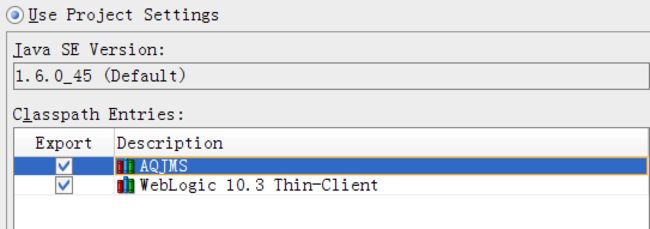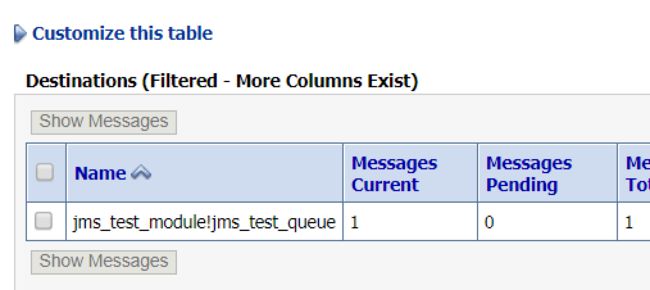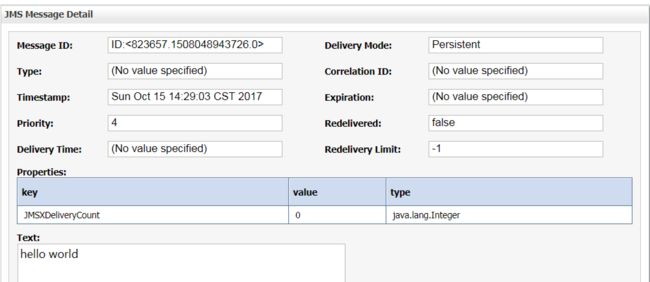在上一篇文章中,介绍了如何在weblogic中创建jms相关资源,下面要介绍如何通过java向jms队列中写入消息以及如何从jms队列中取出消息。
要使用weblogic的jms,需要引入以下两个包
javax.jms.jar-
wlfullclient.jar
如果是使用jdeveloper开发,直接引入以下两个Library即可
消息发送
java将消息发送到消息队列中,需要经过以下步骤
- 连接jms服务器
- 获取连接工厂(Connection Factory)
- 通过连接工厂创建队列连接(QueueConnection)
- 通过队列连接创建队列会话(QueueSession)
- 通过队列会话创建队列生产者(Sender/Product)
- 创建消息(Message)
- 通过生产者将消息发送到队列中
具体代码实现:
package asan.demo.jms;
import java.util.Hashtable;
import javax.jms.JMSException;
import javax.jms.Queue;
import javax.jms.QueueConnection;
import javax.jms.QueueConnectionFactory;
import javax.jms.QueueSender;
import javax.jms.QueueSession;
import javax.jms.Session;
import javax.jms.TextMessage;
import javax.naming.Context;
import javax.naming.InitialContext;
import javax.naming.NamingException;
public class JMSSender {
private QueueSender sender = null;
private QueueSession session = null;
private static final String JMS_FACTORY_JNDI = "jms/jms_test_connection_factory1";
private static final String JMS_QUEUE_JNDI = "jms/jms_test_queue";
public JMSSender() {
super();
}
public void sendMessage(String msg) {
TextMessage textMsg;
try {
if (this.sender == null) {
this.init();
}
textMsg = session.createTextMessage();
textMsg.setText(msg);
sender.send(textMsg);
} catch (JMSException e) {
e.printStackTrace();
} catch (Exception ex) {
ex.printStackTrace();
}
}
// 1. 连接jms服务器
// 2. 获取连接工厂(Connection Factory)
// 3. 通过连接工厂创建队列连接(QueueConnection)
// 4. 通过队列连接创建队列会话(QueueSession)
// 5. 通过队列会话创建队列生产者(Sender/Product)
// 6. 创建消息(Message)
// 7. 通过生产者将消息发送到队列中
private void init() throws NamingException, JMSException {
Hashtable properties = new Hashtable();
properties.put(Context.INITIAL_CONTEXT_FACTORY,
"weblogic.jndi.WLInitialContextFactory");
properties.put(Context.PROVIDER_URL, "t3://127.0.0.1:7101");
properties.put(Context.SECURITY_PRINCIPAL, "weblogic");
properties.put(Context.SECURITY_CREDENTIALS, "weblogic1");
InitialContext ctx = new InitialContext(properties);
QueueConnectionFactory jmsFactory =
(QueueConnectionFactory)ctx.lookup(JMS_FACTORY_JNDI);
QueueConnection jmsConn = jmsFactory.createQueueConnection();
session = jmsConn.createQueueSession(false, Session.AUTO_ACKNOWLEDGE);
Queue queue = (Queue)ctx.lookup(JMS_QUEUE_JNDI);
sender = session.createSender(queue);
}
public static void main(String[]cmd){
JMSSender sender=new JMSSender();
sender.sendMessage("hello world");
}
}
运行程序后登录console,进入domain->Services->Messaging->JMS Module->jms_test_module->jms_test_queue在Monitoring页面可以看到队列中增加一条消息,点击Show Messages可以查看消息详细内容
消息接收
java从消息队列中获取消息,需要经过以下步骤
- 连接jms服务器
- 获取连接工厂(Connection Factory)
- 通过连接工厂创建队列连接(QueueConnection)
- 通过队列连接创建队列会话(QueueSession)
- 通过队列会话创建队列消费者(Reciver/Consumer)
- 接收消息(Message)
和消息发送到步骤差不多。
具体代码实现:
package asan.demo.jms;
import java.util.Hashtable;
import javax.jms.JMSException;
import javax.jms.Message;
import javax.jms.MessageConsumer;
import javax.jms.Queue;
import javax.jms.QueueConnection;
import javax.jms.QueueConnectionFactory;
import javax.jms.QueueSession;
import javax.jms.Session;
import javax.jms.TextMessage;
import javax.naming.Context;
import javax.naming.InitialContext;
import javax.naming.NamingException;
public class JMSReciver {
private MessageConsumer reciver = null;
private static final String JMS_FACTORY_JNDI = "jms/jms_test_connection_factory1";
private static final String JMS_QUEUE_JNDI = "jms/jms_test_queue";
public JMSReciver() {
super();
}
public void reciveMessage() {
try {
if (this.reciver == null) {
this.init();
}
System.out.println("waiting to recive message from jms queue "+JMS_QUEUE_JNDI);
while(true){
Message msg=reciver.receive();
if(msg instanceof TextMessage){
TextMessage textMsg=(TextMessage)msg;
System.out.println("recive jms message:"+textMsg.getText());
}
}
} catch (JMSException e) {
e.printStackTrace();
} catch (Exception ex) {
ex.printStackTrace();
}
}
// 1. 连接jms服务器
// 2. 获取连接工厂(Connection Factory)
// 3. 通过连接工厂创建队列连接(QueueConnection)
// 4. 通过队列连接创建队列会话(QueueSession)
// 5. 通过队列会话创建队列消费者(Reciver/Consumer)
// 6. 接收消息(Message)
private void init() throws NamingException, JMSException {
Hashtable properties = new Hashtable();
properties.put(Context.INITIAL_CONTEXT_FACTORY,
"weblogic.jndi.WLInitialContextFactory");
properties.put(Context.PROVIDER_URL, "t3://127.0.0.1:7101");
properties.put(Context.SECURITY_PRINCIPAL, "weblogic");
properties.put(Context.SECURITY_CREDENTIALS, "weblogic1");
InitialContext ctx = new InitialContext(properties);
QueueConnectionFactory jmsFactory =
(QueueConnectionFactory)ctx.lookup(JMS_FACTORY_JNDI);
QueueConnection jmsConn = jmsFactory.createQueueConnection();
QueueSession session = jmsConn.createQueueSession(false, Session.AUTO_ACKNOWLEDGE);
Queue queue = (Queue)ctx.lookup(JMS_QUEUE_JNDI);
reciver = session.createReceiver(queue);
jmsConn.start();
}
public static void main(String[]cmd){
JMSReciver consumer=new JMSReciver();
consumer.reciveMessage();
}
}
运行程序,控制台打印出队列中消息
JMS客户端
为了更清楚了解jms消息发送过程,这边写了一个客户端,该客户端有两种模式,当作为生产者可以在控制台输入消息发送到消息队列中,当作为消费者,一旦消息队列中有消息产生,立刻将消息打印到控制台。
客户端代码如下:
package asan.demo.jms;
import java.util.Scanner;
public class JMSClient {
public JMSClient() {
super();
}
public static void help() {
System.out.println("Usage:java -jar JMSClient.jar sender/reciver");
System.out.println("sender:向jms队列发送消息");
System.out.println("reciver:从队列中取出消息");
}
public static void main(String[] cmd) {
if (cmd.length == 0) {
help();
return;
}
String mode = cmd[0];
if ("sender".equalsIgnoreCase(mode)) {
JMSSender sender = new JMSSender();
Scanner sc = new Scanner(System.in);
System.out.println("input you message(input end to exit):");
while (true) {
String msg = sc.nextLine();
if ("end".equalsIgnoreCase(msg)) {
return;
}
sender.sendMessage(msg);
}
} else {
JMSReciver consumer = new JMSReciver();
consumer.reciveMessage();
}
}
}
将代码打包(关于如何打包参考这篇文章),jar名称为JMSClient.jar,执行以下命令将客户端作为生产者运行
java -jar JMSClient.jar sender
重新打开一个控制台,执行以下命令将客户端作为消费者运行
java -jar JMSClient.jar reciver
在第一个控制台中输入消息,消息立马在第二个控制台输出
程序稍加改造就能变成一个实时点对点聊天程序,思路是在weblogic中创建两个队列每个客户端对应一个队列,两个客户端分别向对方队列发送消息并从自己的队列中获取消息。





